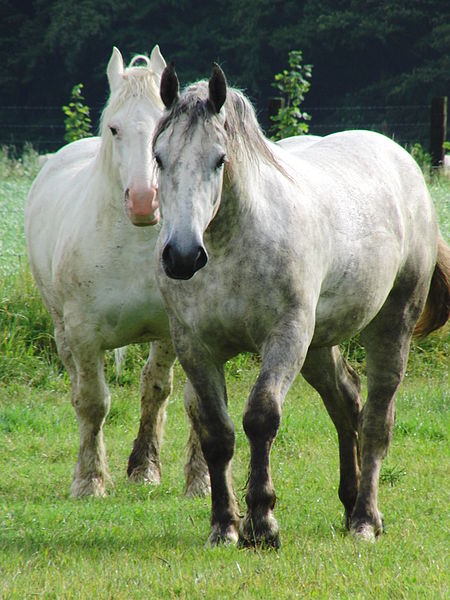The Boulonnais horse
The true origins of this draught horse are unknown. For some, it is descended from horses impregnated with oriental blood that belonged to Julius Caesar’s cavalry, who stayed in the Pas-de-Calais region, known as the Boulonnais. Others believe that they are descended from ancient black horses from Northern Europe, or from horses abandoned by the Huns in the 4th century.

What seems more certain is that the Boulonnais, mentioned in chronicles as early as the 17th century, was influenced by Arab, Andalusian and Mecklenburg horses during the Crusades, the Spanish occupation, and the First Empire. Two types of Boulonnais were distinguished:
- the small one: the “maréeur” or “mareyeur”, fast, like a letter carrier, transporting fish (the “marée”) from Boulogne-sur-Mer to Paris. Now very rare.
- Le grand: big, powerful, obtained in the 19th century, used for agricultural work (ploughing, carting).
The Livre Genealogical was created in 1886, and in 1902, the Riding Syndicate Boulonnais was founded. To combat the decline in numbers, the French National Stud has created a new breed: the Arab-Boulonnais or Arabo-Boulonnais, a good trotter intended for carriage driving or as a leisure saddle horse.
Caractère et aptitudes du cheval
An energetic, spirited horse, a “thoroughbred draught horse” requiring an experienced driver. Powerful and enduring, this is an excellent draught horse. Supple, lively, powerful, very ample gaits.
Utilisations du cheval
Excellent for utility pulling (agricultural work, heavy cartage) or prestige. Since 1991, it has successfully taken part in driving competitions and rural tourism, not forgetting the Route du Poisson endurance race from Boulogne-sur-Mer to Paris, held every two years.
Morphologie du cheval
Elegant, short head with broad, flat forehead. Straight profile. Strong gauntlets. Open nostrils. Small ears. Very bright eyes. Body of brevilinear type. Thick, muscular neck often arched. Withers often drowned in musculature. Perfectly protruding shoulders. Broad fore chest. Broad chest. Well rounded ribs. Straight, broad back. Loin short and broad. Short flanks. Muscular hindquarters. Double croup, slightly oblique. Strong, muscular limbs. Wide, clean, solid joints. Short, thick cannons. Thick tail, high set. Coat: gray, from very light to dark dapple, more rarely chestnut. Fine skin, giving the impression of polished marble. Double mane, bushy, not very long. Stud-book mark: navy anchor on left side of neck. Size by type: 1.55 to 1.60 m for the small model and 1.60 to 1.70 m for the large model. Weight: “small”: 500 to 550 kg and “large”: 700 kg to over a ton.


